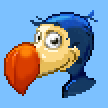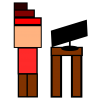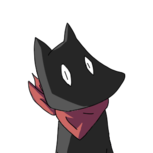Here's my *nix console Tetris which I wrote up couple of years ago while learning Python. It is rather full-featured but I don't know if it will run on Windows (propably not). Other than that I made some console games back when graphical screens were basically non-existent. It always felt nice making things work on crude hardware.
Textris.py
#!/usr/bin/python
"""
TEXTRIS - a console Tetris clone (v0.6)
Free Software by Bert vt Veer
Last update: 27-06-2010
Usage: textris <options>
-h,-help - Prints this help
-s WxH - Board size
-bw - Black & white mode
"""
import curses, math
from sys import argv
from os import path
from time import time, sleep
from random import random
from copy import deepcopy
class Parameters:
parm = {
"ColorMode" : True,
"BoardSize" : "10x20",
"HelpMode" : False
}
def __init__(self):
count = len(argv)
index = 1
while index < count:
parm = argv[index]
if parm == "-bw": self.parm["ColorMode"] = False
elif parm in ["?","-h","-help"]: self.parm["HelpMode"] = True
elif parm == "-s" and index+1 < count:
self.parm["BoardSize"] = argv[index+1]
indez = index+1
index = index+1
class CursesApp:
def __init__(self, colors=True):
self.colors = colors
self.timer = time();
self.fps = 10
self.lines = []
self.keydown = 0
# Init curses
try:
self.stdscr = curses.initscr()
curses.curs_set(0)
curses.noecho()
curses.cbreak()
self.stdscr.nodelay(1)
self.maxy, self.maxx = self.stdscr.getmaxyx()
except:
print "Display error."
sys.exit(1)
# Init color
if self.colors:
curses.start_color()
self.stdscr.bkgd(' ', curses.color_pair(5))
curses.init_pair(1, curses.COLOR_BLACK, curses.COLOR_WHITE)
curses.init_pair(2, curses.COLOR_WHITE, curses.COLOR_BLACK)
curses.init_pair(3, curses.COLOR_YELLOW, curses.COLOR_BLUE)
curses.init_pair(4, curses.COLOR_WHITE, curses.COLOR_RED)
curses.init_pair(5, curses.COLOR_WHITE, curses.COLOR_BLUE)
curses.init_pair(6, curses.COLOR_BLACK, curses.COLOR_GREEN)
curses.init_pair(7, curses.COLOR_BLACK, curses.COLOR_CYAN)
curses.init_pair(8, curses.COLOR_WHITE, curses.COLOR_MAGENTA)
curses.init_pair(9, curses.COLOR_BLACK, curses.COLOR_YELLOW)
curses.init_pair(10, curses.COLOR_BLACK, curses.COLOR_WHITE)
def __del__(self):
try:
curses.nocbreak()
curses.echo()
curses.curs_set(1)
curses.endwin()
except:
pass
def Print(self, x, y, txt, col=0):
self.lines.append((y,x,txt,col))
def BuildScreen(self):
for line in self.lines:
if self.colors:
self.stdscr.addstr(line[0], line[1], line[2], curses.color_pair(line[3]))
else: self.stdscr.addstr(line[0], line[1], line[2])
self.lines = []
#self.stdscr.refresh()
class Stats:
def __init__(self, size):
self.total = [0 for n in range(size)]
self.size = size
self.Reset()
def Reset(self):
self.current = [0 for n in range(self.size)]
class TextAnim:
def __init__(self):
self.Set("",0)
self.active = False
def Set(self, text, duration, blink=0):
self.text = self.text_stor = text
self.duration = duration
self.blink = blink
self.timer = time()
self.active = True
def NextStep(self):
if self.active:
# Do blinking
if self.blink==1:
n = math.floor(math.modf(time())[0]*10)
if n/2 == int(n/2): self.text = " "*len(self.text)
else: self.text = self.text_stor
# Check timer
if time()-self.timer > self.duration:
self.text = self.text_stor = " "*len(self.text)
self.active = False
class Block:
typedef = [
[[0,0,0,0], [1,1,1,1], [0,0,0,0], [0,0,0,0]], # line
[[0,0,0,0], [0,1,1,0], [0,1,1,0], [0,0,0,0]], # Square
[[0,0,0,0], [0,1,1,1], [0,0,1,0], [0,0,0,0]], # T-section
[[0,0,0,0], [0,1,1,0], [0,0,1,1], [0,0,0,0]], # Z-section
[[0,0,0,0], [0,0,1,1], [0,1,1,0], [0,0,0,0]], # S-section
[[0,0,0,0], [0,1,1,1], [0,0,0,1], [0,0,0,0]], # J-section
[[0,0,0,0], [0,1,1,1], [0,1,0,0], [0,0,0,0]] # L-section
]
def __init__(self, x=14, y=10):
self.types = self.typedef
self.shape = int(random()*len(self.types))
self.cells = deepcopy(self.types[self.shape])
self.color = self.shape+1
self.width = 4
self.height = 4
self.x = x
self.y = y
self.isDropping = False
def rotate(self):
dcopy = deepcopy(self.cells)
for y in range(self.height):
for x in range(self.width):
self.cells[y][x] = dcopy[self.width-x-1][y]
class Board:
def __init__(self, width=10, height=20):
self.width = width
self.height = height
self.offsx = 30
self.offsy = 4
self.clear()
def clear(self, value=0):
self.cells = [[value for col in range(self.width)] for row in range(self.height)]
class Game:
hiscore_file = path.expanduser('~')+"/.textris.hiscore"
def __init__(self):
self.textanim = TextAnim()
self.stats = Stats(len(Block.typedef))
# Init board
wh = parms.parm["BoardSize"].split("x")
try: self.board = Board(int(wh[0]), int(wh[1]))
except: self.board = Board()
# Read hiscore
try:
ifile = open(self.hiscore_file, "r")
self.hiscore = int(ifile.readline())
except: self.hiscore = 0
# Start game
self.Reset()
def __del__(self):
# Write hiscore
try:
ofile = open(self.hiscore_file, "w")
ofile.write(str(self.hiscore))
except Exception, exc:
print "Exception:",exc #pass
def Reset(self):
self.board.clear()
self.score = 0
self.level = 0
self.timer = time();
self.framespeed = 0.8
self.lines_total_count = 0
self.removelines = [0 for n in range(self.board.height)]
self.curblock = Block(0,self.board.height)
self.nextblock = Block(self.board.width+4,11)
self.stats.Reset()
self.gamestate = "PLAYING"
#self.textanim.Set("GAME START", 1.5, 1)
def CheckMove(self, dx=0, dy=0):
block = self.curblock
for y in range(block.height):
for x in range(block.width):
px = block.x+x+dx
py = block.y+y+dy
if block.cells[y][x]!=0:
if px<0 or px>=self.board.width or py<-5 or py>=self.board.height: return False
elif py>=0 and self.board.cells[py][px]!=0: return False
return True
def RotateBlock(self):
bcopy = deepcopy(self.curblock)
self.curblock.rotate()
if not self.CheckMove():
self.curblock = bcopy
def RemoveLine(self, y, duration):
# Frames to animate before removal
self.removelines[y] = duration
def RemoveLines(self):
rnd = 1+int(random()*len(self.curblock.types)) # same color for all rows
for y in range(len(self.removelines)):
# Ceck if there are lines to be animated/removed
if self.removelines[y]>0:
self.removelines[y] = self.removelines[y]-1
if self.removelines[y]==0:
# Remove line from board
for x in range(self.board.width): self.board.cells[y][x] = 0
for yb in range(y,0,-1): self.board.cells[yb] = deepcopy(self.board.cells[yb-1])
else:
# Animate colors
for x in range(self.board.width): self.board.cells[y][x] = rnd
def MoveBlock(self, dx=0, dy=0):
block = self.curblock
if self.CheckMove(dx,dy):
block.x = block.x+dx
block.y = block.y+dy
elif dy==1: # Cannot move down
# Draw block onto board
for y in range(block.height):
for x in range(block.width):
px = block.x+x
py = block.y+y
if px>=0 and px<self.board.width and py>=0 and py<self.board.height:
if block.cells[y][x]!=0: self.board.cells[py][px] = block.color
if block.y<0:
# Board filled, game over
self.gamestate = "GAMEOVER"
else:
# Copy active block from nextblock
self.curblock = self.nextblock #deepcopy(self.nextblock)
self.curblock.x = (self.board.width/2)-2
self.curblock.y = -1
#self.curblock.isDropping = False
self.nextblock = Block(self.board.width+4,11)
# Check for filled lines
lines_count = 0
for y in range(self.board.height):
if not 0 in self.board.cells[y]:
self.RemoveLine(y,48+lines_count*8)
lines_count = lines_count+1
# Apply score
if lines_count>0:
points = [0,100,200,500,1000][lines_count]
self.score = self.score + points
if self.score>self.hiscore: self.hiscore = self.score
self.lines_total_count = self.lines_total_count + lines_count
newlevel = int(self.lines_total_count/10)
if newlevel>self.level:
self.level = newlevel
if self.level>=3: self.framespeed = 0.5
if self.level>=8: self.framespeed = 0.4
if self.level>=12: self.framespeed = 0.3
if self.level>=20: self.framespeed = 0.2
if self.level>=30: self.framespeed = 0.1
self.textanim.Set("LEVEL UP", 3, 1)
elif lines_count>1:
self.textanim.Set("BONUS X"+str(lines_count), 2, int(lines_count==4))
# Update statistics
self.stats.current[self.curblock.shape] = self.stats.current[self.curblock.shape] + 1
self.stats.total[self.curblock.shape] = self.stats.total[self.curblock.shape] + 1
class Textris:
def __init__(self):
self.app = CursesApp(parms.parm["ColorMode"]==True)
self.game = Game()
self.block_graph = ["[]", "[_"][int(parms.parm["ColorMode"])]
def DrawScreenLayout(self):
app = self.app
board = self.game.board
# Draw static text
app.Print(0,0," "*(app.maxx),1)
app.Print(2,0,"T E X T R I S - by Bert vt Veer",1)
app.Print(app.maxx-21,0, "textris -h for help",1)
app.Print(4,4,"--CONTROLS-------")
app.Print(4,6,"Arrows - Move")
app.Print(4,7,"Up - Rotate")
app.Print(4,8,"Space - Drop")
app.Print(4,10,"P - Pause")
app.Print(4,11,"Q - Quit")
app.Print(board.offsx + board.width*2+8, 13, "Next:")
# Statistics
app.Print(4,14,"--STATISTICS-----")
chars = ["-", "O", "T", "Z", "S", "J", "L"]
for n in range(len(Block.typedef)):
app.Print(4,16+n," "+chars[n]+" ", 4+n)
# Draw board border
app.Print(board.offsx-1, board.offsy-1, "+"+"--"*board.width+"+")
app.Print(board.offsx-1, board.offsy+board.height, "+"+"--"*board.width+"+")
for y in range(board.height):
app.Print(board.offsx-1, board.offsy+y, "|"+" "*board.width+"|")
def DrawBlock(self, block):
for y in range(block.height):
for x in range(block.width):
px = block.x+x
py = block.y+y
bw = self.game.board.width
bh = self.game.board.height
if block.cells[y][x]!=0 and (py>=0 and py<bh): # or (px>self.game.board.width)): # improve
self.app.Print(self.game.board.offsx+px*2, self.game.board.offsy+py, self.block_graph, block.color+3)
def UpdateScreen(self):
app = self.app
game = self.game
# Draw static blocks
for y in range(game.board.height):
for x in range(0,game.board.width):
curval = game.board.cells[y][x]
if curval!=0: app.Print(game.board.offsx+x*2, game.board.offsy+y, self.block_graph, curval+3)
else: app.Print(game.board.offsx+x*2, game.board.offsy+y, " ", 2)
# Draw active/next block
for y in range(4): app.Print(game.board.offsx+game.board.width*2+8,15+y," ",2) # Clear nextblock
if game.gamestate != "GAMEOVER":
self.DrawBlock(game.curblock)
self.DrawBlock(game.nextblock)
# Draw other stuff
boffs = game.board.offsx + game.board.width*2
app.Print(boffs+8,5, "Score")
app.Print(boffs+14,5,"%7i" % game.score, 3)
app.Print(boffs+8,7, "Level")
app.Print(boffs+14,7,"%7i" % (game.level+1), 3)
app.Print(boffs+8,9, "High %7i" % game.hiscore)
# AnimText
app.Print(boffs+8,22, game.textanim.text, 3)
# Statistics
for n in range(len(Block.typedef)):
app.Print(8,16+n, "%4i (%i) " % (game.stats.current[n], game.stats.total[n]))
# Draw overlay board
winc = game.board.offsx + game.board.width - 9
if game.gamestate == "GAMEOVER":
app.Print(winc, game.board.offsy+7, "+----------------+",1)
app.Print(winc, game.board.offsy+8, "| GAME OVER |",1)
app.Print(winc, game.board.offsy+9, "| press Enter |",1)
app.Print(winc, game.board.offsy+10, "+----------------+",1)
elif game.gamestate == "PAUSED":
app.Print(winc, game.board.offsy+7, "+----------------+",1)
app.Print(winc, game.board.offsy+8, "| PAUSED |",1)
app.Print(winc, game.board.offsy+9, "+----------------+",1)
# Debug output
#app.Print(boffs+8,21, "keydown:%3i" % app.keydown) # debug
#app.Print(1,1,"Exception: "+str(exc))
def Update(self):
app = self.app
game = self.game
# Handle gamestates
if game.gamestate == "PLAYING":
# Check if block has to be moved
if app.keydown == 66 or game.curblock.isDropping or time()-game.timer > game.framespeed:
game.MoveBlock(0,1)
game.timer = time()
# In-game controls
if app.keydown == 65: game.RotateBlock()
if app.keydown == 67: game.MoveBlock(1,0)
if app.keydown == 68: game.MoveBlock(-1,0)
if app.keydown == 32: game.curblock.isDropping = True
if app.keydown == 112: game.gamestate = "PAUSED"
# Line removal animation
game.RemoveLines()
elif game.gamestate == "PAUSED":
if app.keydown == 112: game.gamestate = "PLAYING"
else:
# Other controls
if app.keydown == 10: game.Reset()
# Text animation
game.textanim.NextStep()
def Run(self):
self.DrawScreenLayout()
self.UpdateScreen()
self.app.BuildScreen()
# Main loop
while 1:
self.Update()
curtime = time()
if curtime-self.app.timer > 1/self.app.fps:
self.UpdateScreen()
self.app.BuildScreen()
self.app.timer = time()
self.app.keydown = self.app.stdscr.getch()
if self.app.keydown == 113: break
# Be nice, sleep for a while
sleep(0.01)
#-----------------------------------------------------------------------
# PROGRAM START
#-----------------------------------------------------------------------
#exc = ""
if __name__ == "__main__":
# Parse arguments
parms = Parameters()
if parms.parm["HelpMode"]: print __doc__
else:
textris = Textris().Run()
![]()













